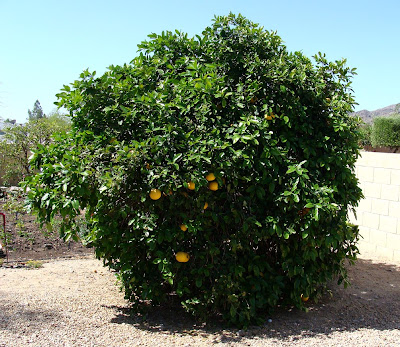 |
| Citrus x paradisi |
PLANT | Citrus x paradisi | Grapefruit, the tree, resulted from a cross (no doubt unintentional) between a sweet orange (Citrus sinensis) and a pummelo (C. maxima). (This knowledge comes not from the historical record, but from genetic analyses conducted many years later.)
The grapefruit tree gets 20-50 ft (6-15 m) tall, is evergreen, and bears white, very fragrant four-petaled flowers in early spring. Grapefruit, the fruit, is intermediate in size between the pummelo and the orange, but unlike either parent, is acidic instead of sweet. (Go figure.) Grapefruit fruits and the flowers that precede them tend to be in clusters, like grapes; hence the name. Grapefruit cultivars include white fleshed varieties: 'Duncan' is probably the hardiest grapefruit; it is rather seedy, but probably the best tasting grapefruit, and usually eaten fresh. |
| Citrus x paradisi |
Like other door yard citrus plantings, grapefruit trees require very little attention. They usually need no supplemental watering; fertilize once a year in spring; enjoy the fruit in winter. The lovely "orange blossom" fragrance attracts bees and the nectar is made into a honey of superior quality. Grapefruits last longer on the tree than most citrus fruits, and sometimes the seeds begin to germinate within the fruits still on the tree.
And Grapefruit trees have large rounded canopies and require plenty of space, more than orange trees, for good growth. They are heavy feeders needing regular applications of fertilizer. There are a multitude of varieties available, some ideal for commercial production and others best suited to backyard orchards. Most are grafted on to rootstocks, which impart tolerances to local soil, pest and climate conditions as well as preserving the desired varietal characteristics.
 |
| Citrus x paradisi |
Though large, these trees can be trained to be more compact via grafting and pruning. Those on dwarfing rootstocks make great tub or conservatory specimens. No backyard orchard in subtropical and tropical zones is complete without at least one prolific and long-lived grapefruit tree.
No comments:
Post a Comment